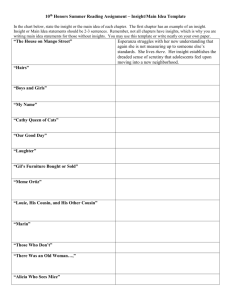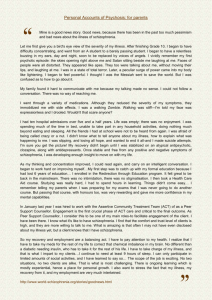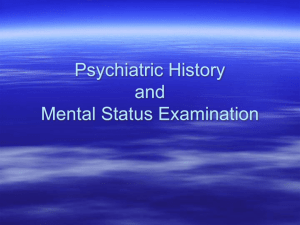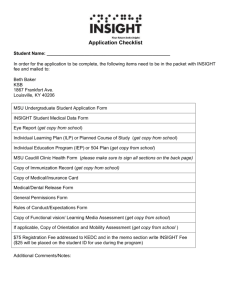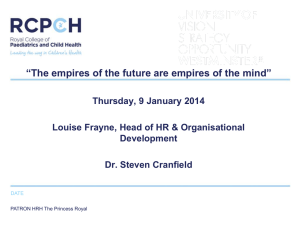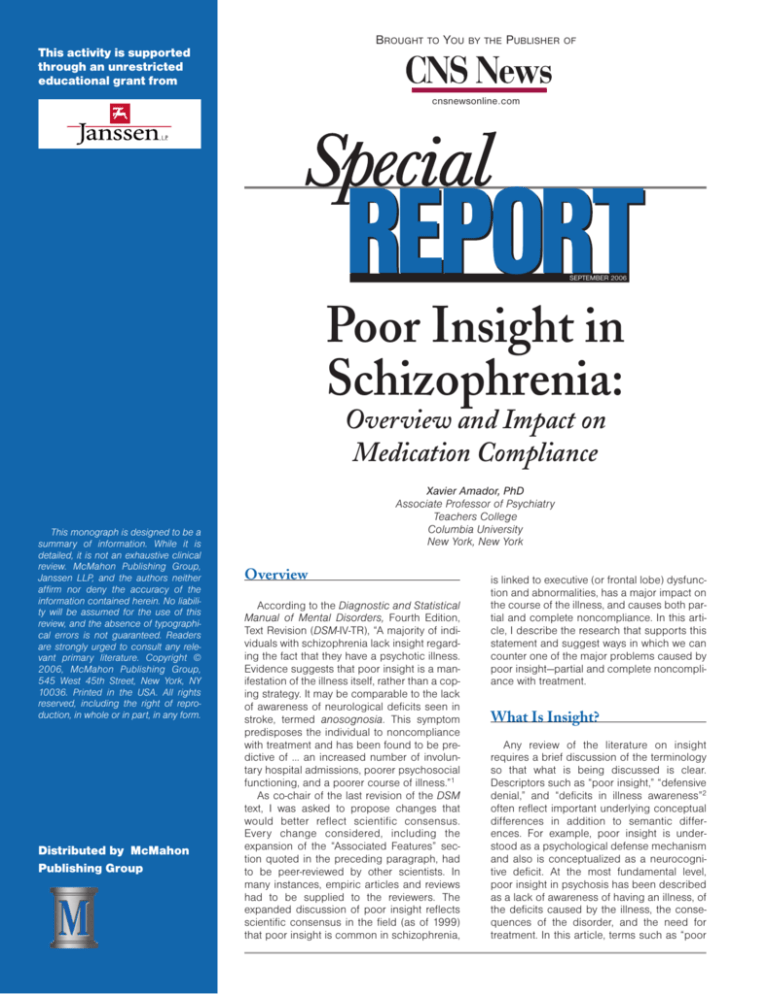
BROUGHT
TO
YOU
BY THE
PUBLISHER
OF
This activity is supported
through an unrestricted
educational grant from
cnsnewsonline.com
SEPTEMBER 2006
Poor Insight in
Schizophrenia:
Overview and Impact on
Medication Compliance
This monograph is designed to be a
summary of information. While it is
detailed, it is not an exhaustive clinical
review. McMahon Publishing Group,
Janssen LLP, and the authors neither
affirm nor deny the accuracy of the
information contained herein. No liability will be assumed for the use of this
review, and the absence of typographical errors is not guaranteed. Readers
are strongly urged to consult any relevant primary literature. Copyright ©
2006, McMahon Publishing Group,
545 West 45th Street, New York, NY
10036. Printed in the USA. All rights
reserved, including the right of reproduction, in whole or in part, in any form.
Distributed by McMahon
Publishing Group
Xavier Amador, PhD
Associate Professor of Psychiatry
Teachers College
Columbia University
New York, New York
Overview
According to the Diagnostic and Statistical
Manual of Mental Disorders, Fourth Edition,
Text Revision (DSM-IV-TR), “A majority of individuals with schizophrenia lack insight regarding the fact that they have a psychotic illness.
Evidence suggests that poor insight is a manifestation of the illness itself, rather than a coping strategy. It may be comparable to the lack
of awareness of neurological deficits seen in
stroke, termed anosognosia. This symptom
predisposes the individual to noncompliance
with treatment and has been found to be predictive of … an increased number of involuntary hospital admissions, poorer psychosocial
functioning, and a poorer course of illness.”1
As co-chair of the last revision of the DSM
text, I was asked to propose changes that
would better reflect scientific consensus.
Every change considered, including the
expansion of the “Associated Features” section quoted in the preceding paragraph, had
to be peer-reviewed by other scientists. In
many instances, empiric articles and reviews
had to be supplied to the reviewers. The
expanded discussion of poor insight reflects
scientific consensus in the field (as of 1999)
that poor insight is common in schizophrenia,
is linked to executive (or frontal lobe) dysfunction and abnormalities, has a major impact on
the course of the illness, and causes both partial and complete noncompliance. In this article, I describe the research that supports this
statement and suggest ways in which we can
counter one of the major problems caused by
poor insight—partial and complete noncompliance with treatment.
What Is Insight?
Any review of the literature on insight
requires a brief discussion of the terminology
so that what is being discussed is clear.
Descriptors such as “poor insight,” “defensive
denial,” and “deficits in illness awareness”2
often reflect important underlying conceptual
differences in addition to semantic differences. For example, poor insight is understood as a psychological defense mechanism
and also is conceptualized as a neurocognitive deficit. At the most fundamental level,
poor insight in psychosis has been described
as a lack of awareness of having an illness, of
the deficits caused by the illness, the consequences of the disorder, and the need for
treatment. In this article, terms such as “poor
insight” and “unawareness of illness” are used in this broadest
sense unless specific aspects of insight, such as awareness of
symptoms, are being described.
Prevalence
In the past 15 years, there has been an explosion of
research into the problem of poor insight. Until recently, the
lack of empiric methods and data, coupled with preconceptions about the causes of poor insight (ie, that it is always
defensive denial), had hampered progress in this area. Despite
these early misunderstandings, the topic has become increasingly important among researchers studying psychotic disorders. A MEDLINE search from 1998 through December 2005
in which the key words/terms “schizophrenia,” “insight into illness,” and “awareness of illness” were used revealed that 200
empiric studies of poor insight in schizophrenia have been
published in the peer-reviewed scientific literature since 1991.
Before that time, there were fewer than 10. Among those was a
report by Carpenter and colleagues, from the World Health
Organization International Pilot Study of Schizophrenia.3 They
found that “poor insight” was among the 12 “most discriminating” symptoms for differentiating schizophrenia from other
mental disorders. Wilson and colleagues found poor insight to
be the most common symptom of schizophrenia, present in
81% of the sample studied.4 However, both studies used a simplistic (ie, dichotomous, single-item) rating of insight, which
lacked reliability and likely overestimated the problem. Most
studies using more psychometrically sound measures of
insight find that approximately one half of patients with schizophrenia lack insight.
In a more recent study, completed as part of the DSM-IV field
trials, more than 400 patients with psychotic disorders from 7
sites across the United States and 1 site in Mexico were examined5 and their insight measured with the Scale to assess
Unawareness of Mental Disorder (SUMD),6 which captures different aspects of illness awareness. The SUMD rates insight on
a Likert scale rather than dichotomously; respondents were
asked to specify their level of agreement with each of a list of
statements—because it is believed that some patients can have
a little insight. The team measured respondents’ insight into
having a mental illness and also their awareness of signs and
symptoms. The results showed that nearly 60% of the patients
with schizophrenia were unaware of being ill.
In clinical terms, when the patients enrolled in the study
described in the preceding paragraph were asked whether
they had any mental, psychiatric, or emotional problems, about
one half answered “no.” Usually, the negative response was
emphatic and at times was followed by unusual explanations of
why they were inpatients on a psychiatric ward. These ranged
from “because my parents brought me here” to stranger
beliefs, such as “I’m just here for a general physical.” Whereas
the majority of patients with depression and anxiety disorders
actively seek treatment because they feel bad and want help,
these individuals, by contrast, were unaware of having a serious mental illness. Unlike people with depression and anxiety,
they never complained about having a mental illness because
from their perspective, they did not have one. Indeed, their
main complaint was usually feeling victimized by their family,
friends, and doctors, who were pressuring them to accept treatment for an illness they believed they did not have.
Nearly 60% of the patients with
schizophrenia and nearly 50% of
the subjects with manic depression
(with psychosis) were unaware of
being ill.
In addition, a significant percentage of those studied were
unaware of the various signs of the illness that had been diagnosed, despite the fact that everyone around them could read-
60
Percent of patients
50
40
30
20
10
0
Anhedonia
Asociality
Delusions
Flat Affect
Symptom
Hallucinations Thought Disorder
Figure. Percentage of patients with schizophrenia who were unaware of the signs and symptoms of their
illness. 5
2
ily recognize the symptoms (eg, thought disorder, mania, hallucinations). The pattern of pervasive unawareness of symptoms,
shown in the Figure, was also found in all the other patients
with a psychotic disorder whom we studied (except those with
psychotic depression). This was the first time anyone had
looked at this issue, so the team was surprised to learn that the
problems with illness awareness did not stop at unawareness
of a diagnosis. The unawareness we were documenting was
severe and pervasive (ie, patients were unaware of their diagnosis and unable to see even the most obvious signs and
symptoms of their illness).
In addition to being severe and pervasive, poor insight is
consistently present in patients with schizophrenia, and like
some negative symptoms, has a strong correlation with noncompliance and thus effectiveness of treatment.7 The fact that
poor insight appears to be a trait of the disorder in many
patients may help to further subtype patients with schizophrenia along a domain of psychopathology with strong predicative
validity.7,8 In particular, my colleagues and I have proposed that
severe and persistent unawareness of one’s disease is a manifestation of the frontal lobe pathology that leads to significant
problems with treatment adherence.
Etiology of Poor Insight
In my experience, many clinicians still believe that poor
insight in schizophrenia is almost always a consequence of
denial—a defensive coping strategy—or due to a lack of education about the illness (ie, the patient does not yet know the
terms used to describe the illness and symptoms). In 1991,
my colleagues and I hypothesized that poor insight shared an
etiology with certain types of anosognosia in neurologic disorders.2 Studies have looked at whether poor insight is best
explained as due to denial, a lack of education about the illness, or neurocognitive deficit (ie, executive dysfunction).
Studies conducted over the past decade clearly point to executive dysfunction rather than other causes as explaining
severe and persistent lack of insight in schizophrenia. That
does not mean that denial and psychoeducation are never
relevant or clinically meaningful. However, these factors play
a very small role in predicting poor insight in comparison with
executive dysfunction.9
In the first study to test our hypothesis, Young et al10 found
a significant correlation between unawareness of illness as
measured by the SUMD and 2 variables on the Wisconsin
Card Sorting Task (WCST), a neuropsychological test sensitive
to frontal lobe dysfunction. The percentage of perseverative
responses and number of categories completed on the WCST
were found to significantly correlate with the total symptom
awareness and total symptom attribution scores as measured
by the SUMD. The researchers also classified the sample into
high- and low-awareness groups and performed a discriminant function analysis to determine which of a set of variables
most significantly distinguished between the high- and lowawareness groups. They found that a combination of perseverative errors and average symptom severity correctly
categorized 83.9% of the high- and low-awareness groups.
This study offered the first empiric support of our hypothesized relationship between poor insight and frontal lobe dysfunction. Studies that directly measured the relationship
between poor insight and neuropsychological function have
been comprehensively reviewed by Morgan and colleagues,11
who determined that the overwhelming majority of studies testing this hypothesis have found significant relationships
between measures of frontal function (in particular the WCST)
and measures of insight into illness.
The DSM text cited at the beginning of this article emphasizes that poor insight in schizophrenia is a symptom of the disorder. Today, there is widespread consensus in the field that
schizophrenia is a biologically based brain disorder and that
the symptoms of the illness (eg, delusions, negative symptoms)
stem from brain dysfunction. More than 30 years of empiric
research clearly characterize severe unawareness of illness in
schizophrenia as a common feature of the disorder, and it is for
this reason—as well as the studies finding correlations between
unawareness and neuropsychological deficit—that one can
state with confidence that severe and persistent unawareness
of illness in schizophrenia is a symptom of schizophrenia. Furthermore, I believe that just as we label fixed, false beliefs that
persist over time despite contradictory evidence as “delusions,” the time has come to label unawareness that is severe,
persists over long periods of time, and is associated with cognitive deficits as anosognosia. Patients with such severe
deficits in insight should be given a diagnosis of “anosognosia
for schizophrenia” rather than “poor insight.”
Clinical Significance of Poor Insight
Poor insight is among the best predictors of nonadherence
to treatment.12 It is common sense really. Who would want to
take medicine for an illness they did not believe they had? Not
surprisingly, poor insight also predicts a poorer course of illness (eg, increased number of relapses and hospitalizations,
and deteriorating work performance, social skills, quality of
social relationships, and other measures of illness course and
recovery). Whether these findings are a consequence of poor
adherence (either complete and/or partial nonadherence) or a
direct consequence of the underlying pathophysiology of
anosognosia is unknown. What is well replicated, however, is
that unawareness of illness is associated with a range of problems, not the least of which is nonadherence to medication.
Treatment Options To Improve Compliance
Very often clinicians are asked, “What medication is best?”
The answer, if one relies on the research, is “none.” My experience and the science agree that we cannot reliably predict
which medication will be best for any particular individual.
When deciding on a specific medication, one needs to weigh—
among other things—how well it is working against the side
effects for that individual. In some instances, cost is also a
deciding factor.
Just as we label fixed, false beliefs that
persist over time despite contradictory
evidence as “delusions,” the time has
come to label unawareness that is
severe, persists over long periods of
time, and is associated with cognitive
deficits as anosognosia.
That said, however, I do believe that certain generalizations
can be made when it comes to choosing medications for people with a history of poor insight and compliance issues with
3
The fewer the doses, the fewer the
opportunities the person will have to
consciously or unconsciously decide to
skip a dose or simply to forget.
Long-acting injectables are an effective method for reducing partial compliance or noncompliance. I often recommend
a long-acting injectable drug, which not only makes it easier
for the patient and easier for me to monitor compliance but
also does away with other issues. For example, the person
administering the dose does not have to ask the patient to
open his or her mouth to prove that the pills have been swallowed. There is research that supports what I have learned
from personal experience.13 This essential finding has been
replicated numerous times.
As a final comment on the subject of medication, I would like
to speak to a question I am frequently asked: If anosognosia
(poor insight) is a symptom of mental illness, like flat affect or
hallucinations, can medications help? Few studies have examined this question specifically. Generally, anosognosia, like other
negative symptoms, appears to be resistant to drug treatment.
4
In Summary
Poor insight is common in schizophrenia. Approximately
one half of all patients exhibit severe, pervasive, and persistent
problems with insight. Psychoeducation does not remedy the
problem because it stems from neuropsychological deficits. In
such cases, I have proposed that the term “anosognosia for
schizophrenia” be used instead of the broader term “poor
insight.” Anosognosia for schizophrenia results in a poorer
course of illness and problems with treatment adherence. I
have argued that when such patients are treated, simplification
of dosing, increased supervision, and, if possible, long-acting
injectable medications in preference to oral therapies are likely
to be effective.
References
1. Diagnostic and Statistical Manual of Mental Disorders, Fourth Edition, Text
Revision. Washington, DC: American Psychiatric Association; 2000.
2. Amador XF, Strauss DH, Yale SA, Gorman JM. Awareness of illness in schizophrenia. Schizophr Bull. 1991;17:113-132.
3. Carpenter WT Jr, Strauss JS, Bartko JJ. Flexible system for the diagnosis of
schizophrenia: report from the WHO International Pilot Study of Schizophrenia.
Science. 1973;182:1271-1277.
4. Wilson WH, Ban TA, Guy W. Flexible system criteria in chronic schizophrenia.
Compr Psychiatry. 1986;27:259-265.
5. Amador XF, Flaum M, Andreasen NC, et al. Awareness of illness in schizophrenia, schizoaffective and mood disorders. Arch Gen Psychiatry. 1994;51:826836.
6. Amador XF, Strauss DH, Yale S, et al. Assessment of insight in psychosis. Am J
Psychiatry. 1993;150:873-879.
7. Amador XF, Gorman JM. Psychopathologic domains and insight in schizophrenia. Psychiatr Clin North Am. 1998;21:27-42.
8. Ratakonda S, Gorman JM, Yale SA, Amador XF. Characterization of psychotic
conditions: use of the domains of psychopathology model. Arch Gen Psychiatry. 1998;55:75-81.
9. Kasapis C, Amador XF, Yale SA, et al. Neuropsychological and defensive
aspects of poor insight and depression in schizophrenia. Schizophr Res.
1998;18:117-118.
10. Young DA, Davila R, Scher H. Unawareness of illness and neuropsychological
performance in chronic schizophrenia. Schizophr Res.1993;10:117-124.
11. Morgan K, David A. Neuropsycological studies of insight in patients with psychotic disorders. In: Amador XF, David AS, eds. Insight and Psychosis: Awareness of Illness in Schizophrenia and Related Disorders. 2nd ed. New York, NY:
Oxford University Press; 2004:177-193.
12. Amador XF, Kronengold H. Understanding and assessing insight. In: Amador
XF, David AS, eds. Insight and Psychosis: Awareness of Illness in Schizophrenia and Related Disorders. 2nd ed. New York, NY: Oxford University Press;
2004:3-30.
13. Kane JM. Strategies for improving compliance in treatment of schizophrenia by
using a long-acting formulation of an antipsychotic: clinical studies. J Clin Psychiatry. 2003;64(suppl 16):34-40.
SR557
regard to taking their medication. In short, keep the dosing
simple and make it easier for the person to continue taking
the medicine.
It is far easier to monitor a patient’s compliance when the
medicine is taken biweekly or only once or twice a day than
when it must be taken several times a day or more. And it is
also easier for the person taking the medicine to remember
and not succumb to an unconscious desire to skip a dose. The
fewer the doses, the fewer the opportunities the person will
have to consciously or unconsciously decide to skip a dose or
simply to forget.
The problems that arise for patients, their caregivers, and the
treatment team from such partial compliance can be more subtle, but no less significant, than what happens when the patients
stop taking their medication completely. For one thing, if the doctor and family believe a patient is taking medication regularly and
it does not appear to be working, they will assume it has been
given a fair trial when that is far from the truth. I have seen many
medications written off as ineffective for a particular individual
because no one knew the person was missing many, but not all,
doses. However, even if the medicine appears to have some—but
not enough—benefit, the doctor may be afraid to raise a high
dose even higher when, in fact, the patient is not taking the entire
dose that was prescribed in the first place.

